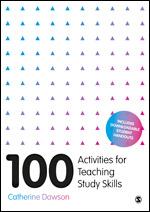SECTION 1: STUDY PREPARATION
Activity 1: Bringing learning to life
Activity 2: Becoming a reflective learner
Activity 3: Learning to learn
Activity 4: Recognising, analysing and critiquing learning styles
Activity 5: Developing metacognition
Activity 6: Improving concentration and memory
Activity 7: Recognising and overcoming imposter syndrome
Activity 8: Fostering collaborative learning and interaction
SECTION 2: ORGANISATION AND TIME MANAGEMENT
Activity 9: Making the right learning choices
Activity 10: Preparing a study plan
Activity 11: Managing time
Activity 12: Completing coursework and meeting deadlines
Activity 13: Organising study
Activity 14: Overcoming organisation problems
Activity 15: Maximising productivity
SECTION 3: READING
Activity 16: Developing academic reading
Activity 17: Establishing academic reading groups
Activity 18: Producing a personal reading strategy
Activity 19: Adopting different reading styles
Activity 20: Searching for literature
Activity 21: Organising and citing reading
Activity 22: Reading and critiquing research reports and papers
SECTION 4: WRITING
Activity 23: Improving spelling, punctuation and grammar
Activity 24: Developing academic writing skills
Activity 25: Establishing academic writing circles
Activity 26: Structuring essays and assignments
Activity 27: Editing and proofreading
Activity 28: Overcoming writer’s block
Activity 29: Getting the most from tutor feedback
SECTION 5: LISTENING, OBSERVING AND NOTE-TAKING
Activity 30: Becoming an active listener
Activity 31: Improving listening skills
Activity 32: Using audio devises
Activity 33: Improving observation skills
Activity 34: Getting the most out of lectures and seminars
Activity 35: Taking notes effectively
Activity 36: Editing and organising notes
SECTION 6: SCIENCE AND MATHS
Activity 37: Reading scientific material
Activity 38: Knowing about the scientific method
Activity 39: Maths for unconfident adults
Activity 40: Undertaking experiments
Activity 41: Producing scientific reports and papers
Activity 42: Interpreting and critiquing data
Activity 43: Using data visualisation tools
SECTION 7: INDEPENDENT STUDY
Activity 44: Planning independent study
Activity 45: Getting the most from the library
Activity 46: Conducting online research
Activity 47: Using primary and secondary sources
Activity 48: Evaluating sources
Activity 49: Organising, managing and storing information
Activity 50: Finding truth and fact in mass information
SECTION 8: GROUP-WORK
Activity 51: Establishing study groups
Activity 52: Getting the most out of group-work
Activity 53: Producing group assignments
Activity 54: Introducing online study groups
Activity 55: Using online tools for collaborative study
Activity 56: Surviving virtual group-work
SECTION 9: IT, ASSISTIVE LEARNING AND E-LEARNING
Activity 57: Gaining confidence with IT for academic study
Activity 58: Making the most of IT facilities and support
Activity 59: Using software for research
Activity 60: Getting the most out of online learning
Activity 61: Making the most of assistive technology
Activity 62: Introducing data mining
Activity 63: Finding and using datasets
Activity 64: Knowing about data protection
SECTION 10: DISSERTATIONS, REPORTS AND PROJECTS
Activity 65: Planning and managing personal projects
Activity 66: Using statistics, facts, arguments and opinions
Activity 67: Producing an effective argument
Activity 68: Citing, referencing and producing a bibliography
Activity 69: Producing successful written work
Activity 70: Making oral presentations
Activity 71: Producing a dissertation
SECTION 11: RESEARCH AND ENQUIRY
Activity 72: Producing a research proposal
Activity 73: Undertaking a literature review
Activity 74: Choosing research topics and methods
Activity 75: Improving interview techniques
Activity 76: Designing questionnaires
Activity 77: Running focus groups
Activity 78: Introducing data analysis techniques
SECTION 12: CRITICAL AND CREATIVE THINKING
Activity 79: Developing thoughts and imagination
Activity 80: Reflecting, thinking and making connections
Activity 81: Learning how to question
Activity 82: Solving problems
Activity 83: Hypothesising and theorising
Activity 84: Reasoning inductively and deductively
Activity 85: Analysing and critiquing
Activity 86: Applying learning
SECTION 13: REVISION, EXAMINATIONS AND TESTS
Activity 87: Understanding the reasons for assessment
Activity 88: knowing about the different types of assessment
Activity 89: Revising effectively
Activity 90: Preparing for an exam
Activity 91: Taking an exam
Activity 92: Improving exam marks
Activity 93: Coping with stress
SECTION 14: ETHICS AND INTEGRITY
Activity 94: knowing about plagiarism
Activity 95: Recognising and avoiding academic malpractice
Activity 96: Recognising ethical issues and dilemmas when using the internet
Activity 97: Recognising subjectivity and objectivity
Activity 98: Detecting and avoiding bias
Activity 99: Collaborating and cooperating ethically
Activity 100: Undertaking ethical research








